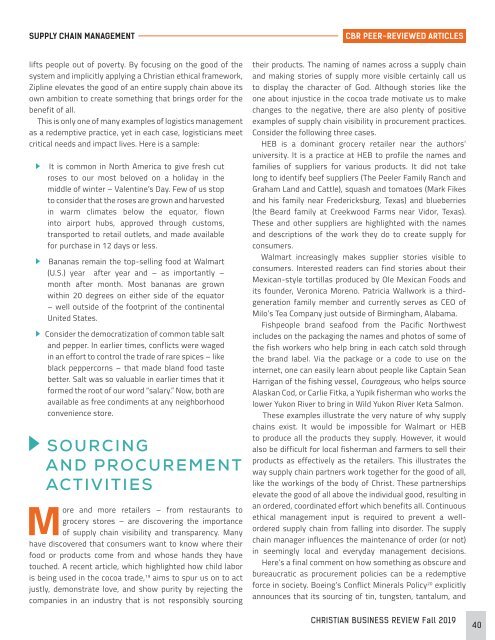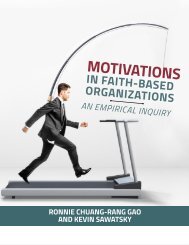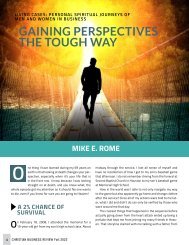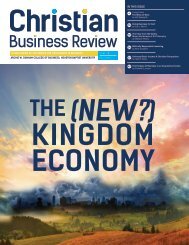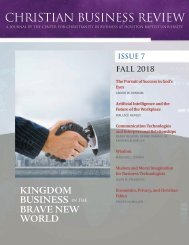Christian Business Review 2019: Workplace Practices That Glorify God (Issue 8)
Create successful ePaper yourself
Turn your PDF publications into a flip-book with our unique Google optimized e-Paper software.
SUPPLY CHAIN MANAGEMENT<br />
CBR PEER-REVIEWED ARTICLES<br />
lifts people out of poverty. By focusing on the good of the<br />
system and implicitly applying a <strong>Christian</strong> ethical framework,<br />
Zipline elevates the good of an entire supply chain above its<br />
own ambition to create something that brings order for the<br />
benefit of all.<br />
This is only one of many examples of logistics management<br />
as a redemptive practice, yet in each case, logisticians meet<br />
critical needs and impact lives. Here is a sample:<br />
It is common in North America to give fresh cut<br />
roses to our most beloved on a holiday in the<br />
middle of winter – Valentine’s Day. Few of us stop<br />
to consider that the roses are grown and harvested<br />
in warm climates below the equator, flown<br />
into airport hubs, approved through customs,<br />
transported to retail outlets, and made available<br />
for purchase in 12 days or less.<br />
Bananas remain the top-selling food at Walmart<br />
(U.S.) year after year and – as importantly –<br />
month after month. Most bananas are grown<br />
within 20 degrees on either side of the equator<br />
– well outside of the footprint of the continental<br />
United States.<br />
Consider the democratization of common table salt<br />
and pepper. In earlier times, conflicts were waged<br />
in an effort to control the trade of rare spices – like<br />
black peppercorns – that made bland food taste<br />
better. Salt was so valuable in earlier times that it<br />
formed the root of our word “salary.” Now, both are<br />
available as free condiments at any neighborhood<br />
convenience store.<br />
SOURCING<br />
AND PROCUREMENT<br />
ACTIVITIES<br />
More and more retailers – from restaurants to<br />
grocery stores – are discovering the importance<br />
of supply chain visibility and transparency. Many<br />
have discovered that consumers want to know where their<br />
food or products come from and whose hands they have<br />
touched. A recent article, which highlighted how child labor<br />
is being used in the cocoa trade, 19 aims to spur us on to act<br />
justly, demonstrate love, and show purity by rejecting the<br />
companies in an industry that is not responsibly sourcing<br />
their products. The naming of names across a supply chain<br />
and making stories of supply more visible certainly call us<br />
to display the character of <strong>God</strong>. Although stories like the<br />
one about injustice in the cocoa trade motivate us to make<br />
changes to the negative, there are also plenty of positive<br />
examples of supply chain visibility in procurement practices.<br />
Consider the following three cases.<br />
HEB is a dominant grocery retailer near the authors’<br />
university. It is a practice at HEB to profile the names and<br />
families of suppliers for various products. It did not take<br />
long to identify beef suppliers (The Peeler Family Ranch and<br />
Graham Land and Cattle), squash and tomatoes (Mark Fikes<br />
and his family near Fredericksburg, Texas) and blueberries<br />
(the Beard family at Creekwood Farms near Vidor, Texas).<br />
These and other suppliers are highlighted with the names<br />
and descriptions of the work they do to create supply for<br />
consumers.<br />
Walmart increasingly makes supplier stories visible to<br />
consumers. Interested readers can find stories about their<br />
Mexican-style tortillas produced by Ole Mexican Foods and<br />
its founder, Veronica Moreno. Patricia Wallwork is a thirdgeneration<br />
family member and currently serves as CEO of<br />
Milo’s Tea Company just outside of Birmingham, Alabama.<br />
Fishpeople brand seafood from the Pacific Northwest<br />
includes on the packaging the names and photos of some of<br />
the fish workers who help bring in each catch sold through<br />
the brand label. Via the package or a code to use on the<br />
internet, one can easily learn about people like Captain Sean<br />
Harrigan of the fishing vessel, Courageous, who helps source<br />
Alaskan Cod, or Carlie Fitka, a Yupik fisherman who works the<br />
lower Yukon River to bring in Wild Yukon River Keta Salmon.<br />
These examples illustrate the very nature of why supply<br />
chains exist. It would be impossible for Walmart or HEB<br />
to produce all the products they supply. However, it would<br />
also be difficult for local fisherman and farmers to sell their<br />
products as effectively as the retailers. This illustrates the<br />
way supply chain partners work together for the good of all,<br />
like the workings of the body of Christ. These partnerships<br />
elevate the good of all above the individual good, resulting in<br />
an ordered, coordinated effort which benefits all. Continuous<br />
ethical management input is required to prevent a wellordered<br />
supply chain from falling into disorder. The supply<br />
chain manager influences the maintenance of order (or not)<br />
in seemingly local and everyday management decisions.<br />
Here’s a final comment on how something as obscure and<br />
bureaucratic as procurement policies can be a redemptive<br />
force in society. Boeing’s Conflict Minerals Policy 20 explicitly<br />
announces that its sourcing of tin, tungsten, tantalum, and<br />
CHRISTIAN BUSINESS REVIEW Fall <strong>2019</strong><br />
40 2


